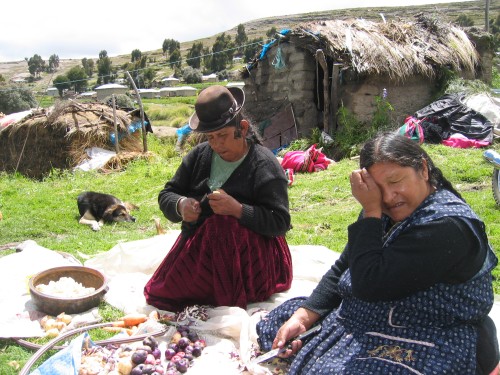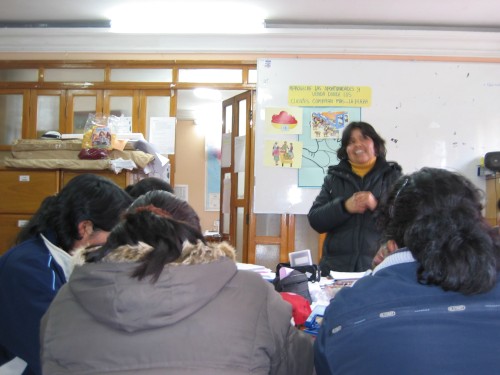Some of you may be aware of the definition of the Community, or Village, Bank and the role it plays in many Microfinance Institutions (MFIs). For those of you who are not familiar with the concept, I’d like to offer a brief history of the Community Bank and it’s function in Manuela Ramos, an MFI and women’s movement in Peru. Although community banks operate differently in distinct countries and MFIs, the origin of the community bank and it’s general functions are usually the same regardless of the place of operation.
The idea of the Community Bank originated with the development of the first MFI, the Grameen Bank, in the early 1980s. Muhammad Yunus, and economists from Bangladesh, saw a great need for small loans to become available for the working poor in his country. Like any bank that provides loans, this bank needed a guarantee from the borrowers that the loans would be repaid. This guarantee could not come in the form of collateral, such as a house or automobile, because the borrowers, for the most part, had no collateral to offer. Therefore, in order to ensure the bankers that the loans would be repaid, Muhammad Yunus developed the concept of the Village, or Community, Bank, where groups of people from the same village would come together and take out a group loan to be used for individual businesses. In this way, the group members support each other in the development of their individual businesses and guarantee that each member will repay his or her loan. Over the last 30 years as MFIs have started in much of the developing world, the practice of Community Banking has spread and been adapted to fit the needs of the specific MFIs.
Manuela Ramos, the MFI with which I have been volunteering as a Kiva Fellow for the last three months, originated in 1978 as an organization to fight for women’s rights throughout Peru. Twelve years ago, Manuela Ramos started a microfinance program, CrediMujer, and has since expanded this program to seven of their offices. The foundation of this program and much of its success rests in the implementation of the idea of the Community Bank. A community bank of Manuela Ramos can begin with as little as five women who decide they would like to create a group and begin taking out loans together. In order to start the community bank, the women must assign a president, secretary and treasure and each put 25 soles (approximately $8 USD) into the banks internal savings account. As the women invite more members to their group, their internal savings account grows, as does the amount each individual is allowed to borrow. Since a woman can join the community bank only with an invitation from an existing member and the approval of the entire community bank, the women assume the responsibility that each community bank member will repay their loan.
There are many advantages embedded in operating with community banks, the most obvious being the security this system offers Manuela Ramos. Although Manuela Ramos requires that each woman provide 25 soles and a copy of a photo ID of the woman or her husband in order to become a community bank member, Manuela Ramos does not require any other form of collateral. The liability of default is passed along to the community bank members and if one woman defaults on her loan, the entire community bank cannot take out additional loans until the defaulted woman has repaid. Because the members of the community bank come from the same town and are, for the most part, friends, most women do not default on their loans. If a woman does default, it is usually for personal or family reasons that were unforeseen and the other members of the community bank are willing to help. In the case that the community bank members pay back another woman’s loan, the bank members use their individual savings, which are kept in the bank’s internal savings account, to cover the repayment. However, the woman who has defaulted is then in debt to her entire community bank, and the other community bank members usually require the defaulted woman to provide them with a form of collateral, which is generally a television set or livestock, that can easily be kept at a community bank member’s home. The loan officers keep track of women who have defaulted on their loans and, if these women do not eventually repay their fellow community bank members, these women are considered credit risks and are not permitted to take out loans with Manuela Ramos, or any other bank in Peru. Therefore, the incentive to repay the loans is high, and Manuela Ramos’s CrediMujer program currently operates with a 98.5% loan repayment rate.
Another positive aspect of the community banking system of Manuela Ramos is that the banks bring women together and the women learn from each other, benefit from the training and information sessions offered by Manuela Ramos’s loan officers, and save a portion of their earnings in the community bank’s internal savings account. When a community bank is started with Maneula Ramos, the loan officers give an initial training session with the bank members, where the loan officers teach the entrepreneurs some business tips. As a group, the loan officers and the entrepreneurs discuss successes and failures in their past businesses, appropriate times of the year to buy and sell specific products, and the loan officers hand out calendars that provide details about the markets of the surrounding towns. As the community bank grows, the loan officers educate new members and give presentations about business, savings, and women’s rights at about half of the community bank meetings, which happen once a month. In addition to education surrounding business and women’s rights, the entrepreneurs are taught about the importance of savings and are required to save a portion of their earnings in the community banks internal savings account. If an entrepreneur decides to leave the bank, she may take out her savings at any time.
Many microfinance experts argue that the education that is provided to entrepreneurs with their loans is a vital component to the success of these entrepreneurs businesses and therefore to the success of the MFI. However, others might argue that the education sessions are too specific and that, in providing finite details about how to operate a certain business in a specific region, ingenuity in business development is not encouraged. While there may be some truth to the latter argument, my experience in working with Manuela Ramos entrepreneurs has made me believe that the education provided with the loans is more of a benefit than a detriment in helping these women start and sometimes expand their businesses. My belief stems from the conversations that I’ve had with the entrepreneurs surrounding this topic and the fact that fresh business ideas thrive in environments where business and education opportunities are prevalent, which is unfortunately not the case in the Andes of Peru.



